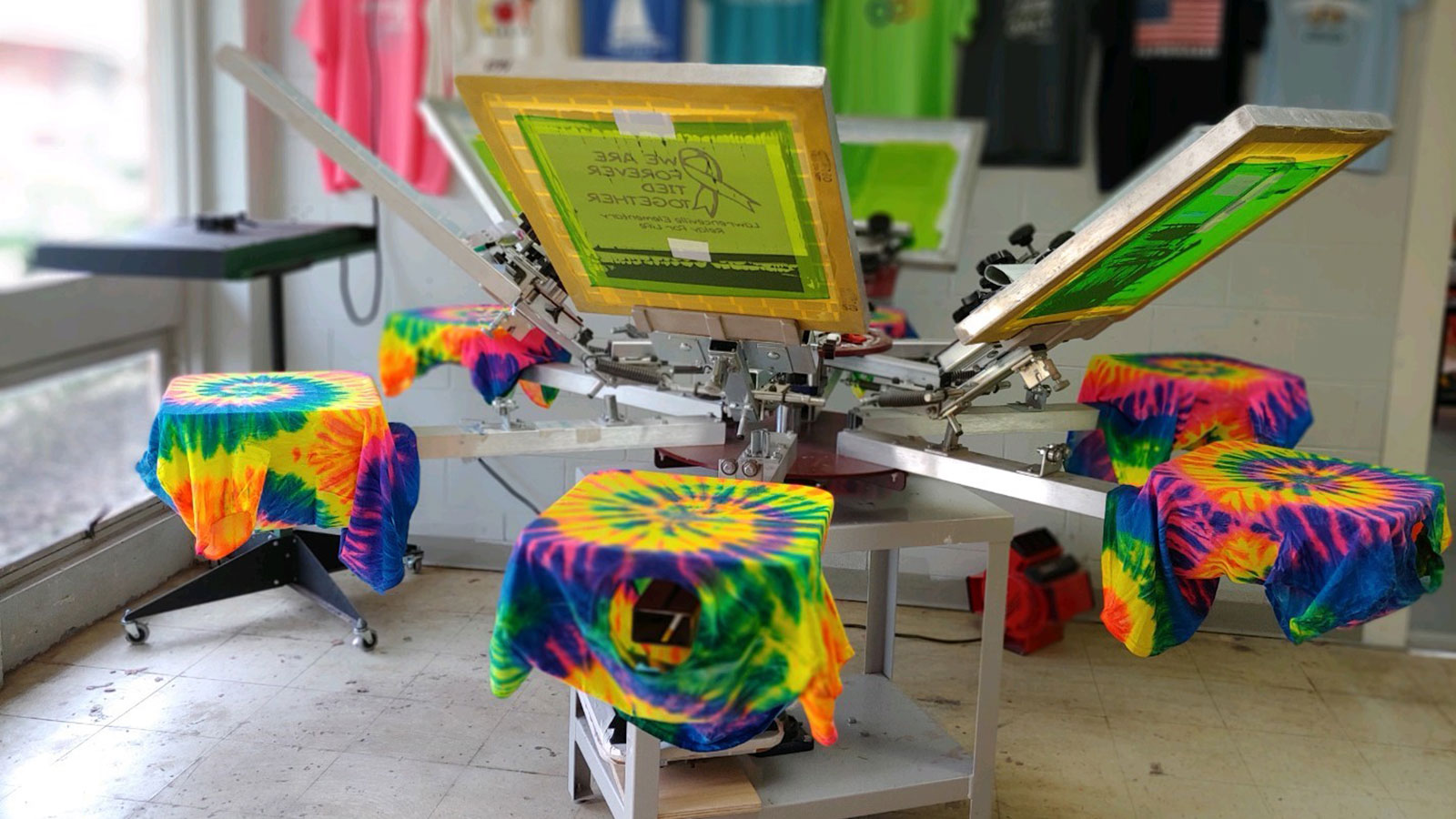High-Volume T-Shirt Printing for Schools and Organizations
High-Volume T-Shirt Printing for Schools and Organizations
Blog Article
Screen Printing Uncovered: Whatever You Required to Learn About Tee Shirt and Garment Printing Strategies
If you've ever before questioned exactly how those vivid layouts wind up on your favorite t-shirts, you're in the right location. Screen printing is a fascinating approach that combines art with technique, supplying countless opportunities for creative thinking. Understanding the fundamentals, from equipment to ink options, can greatly affect your results. Prepared to check out the crucial aspects that make screen printing an art kind? Let's uncover the details that can raise your projects.
The Essentials of Display Printing: Just How It Works
When you dive into display printing, you'll discover it's both a science and an art. At its core, display printing entails developing a pattern, or display, that permits ink to pass through only in particular areas (screen printing kit). You start by picking your design and preparing your screen with a light-sensitive emulsion. Once you expose this solution to light, it solidifies, leaving your design as an unfavorable space.
Following, you'll blend your inks and prepare your printing surface area. Setting the screen over the textile, after that utilize a squeegee to press ink through the screen onto the garment. This procedure calls for precision, as you desire clear, vivid prints. After printing, you'll heal the ink with warm, ensuring it sticks to the textile and lasts via washes. Each action is vital, and grasping them will boost your screen printing skills, transforming simple garments right into unique, meaningful items.
Sorts Of Display Printing Methods
As soon as you grasp the fundamentals of screen printing, it's time to check out the different methods that can raise your styles. One preferred method is conventional screen printing, where ink is pushed through a stenciled screen. This technique is great for strong, dynamic shades. There's water-based ink printing, which supplies a softer feel and is green, but it calls for a various technique to curing.
If you're aiming for great information, think about discharge printing. This method removes dye from the material, leaving a soft, vintage appearance. An additional choice is plastisol printing, recognized for its sturdiness and brilliant colors, making it a favorite for lots of brand names. Ultimately, try out halftone printing to create slope impacts and intricate designs. Each technique has its special appeal, so do not wait to try them out to discover what fits your design best!
Essential Tools for Display Printing
To attain magnificent results in display printing, having the ideal equipment is basic. You'll need a sturdy screen printing framework, which holds the mesh that moves your layout onto the garment. Next, spend in top notch squeegees; these are vital for applying ink uniformly throughout the screen.
Picking the Right Inks and Materials
When selecting inks and materials for screen printing, you need to take right into account the kind of ink that works ideal for your project. Think concerning fabric compatibility to ensure your styles look last and terrific lengthy. Also, explore green ink choices to make your printing process extra lasting.
Kinds of Screen Inks
Picking the appropriate display ink is essential for attaining vibrant, durable prints that satisfy your task's needs. There are numerous sorts of display inks to analyze. Plastisol ink is prominent for its adaptability and convenience of usage, supplying exceptional shade opacity on dark textiles. Water-based ink, on the other hand, provides a softer feel and is environmentally friendly, making it optimal for those wanting to reduce their environmental effect. Discharge inks remove color from the material, leading to a soft, vintage look but need specific handling. Specialty inks, such as glow-in-the-dark or metal, can add one-of-a-kind impacts to your designs. Examine your task needs and select the ink that aligns best with your desired result.

Material Compatibility Factors To Consider
Comprehending textile compatibility is essential for accomplishing high-grade display prints, specifically because different materials react distinctively to numerous inks. Always test your inks on example textile to guarantee they adhere effectively and keep shade integrity. Furthermore, keep in mind that textile weight and structure can affect the last outcome, so selecting the appropriate ink and material combination is essential for your job's success.
Eco-Friendly Ink Options
Environmentally friendly inks are becoming a preferred choice for display printers who desire to minimize their environmental influence while maintaining high quality. When selecting inks, think about water-based inks, which are less dangerous and much easier to cleanse up contrasted to traditional solvents. These inks bond well with fabrics, providing vivid outcomes without hazardous chemicals. You might also explore eco-solvent inks that utilize less unstable organic substances (VOCs), making them a more secure option for both your health and the planet.
Furthermore, look for inks made from sustainable resources, such as soy or vegetable-based alternatives. By picking the best inks and products, you'll not just produce spectacular designs however likewise add to an extra sustainable printing procedure. Make the switch, and your prints will certainly show your dedication to the setting!
Preparing Your Style for Display Printing

File Format Requirements
To ensure your style looks vivid and sharp on textile, you'll require to pay attention to file layout demands for screen printing. Begin with vector data like AI or EPS, as they can be scaled without losing top quality. If you use raster pictures, select high-resolution files, such as TIFF or PNG, preferably at 300 DPI. Stay clear of making use of JPEGs, as they can lose clarity when resized. Make sure your layout has a transparent history to prevent unwanted white edges on your prints. Maintain shade modes in mind; CMYK is basic for screen printing, so transform your RGB develops as necessary - screen printing kit. By following these guidelines, you'll establish your art work up for an effective print.
Color Separation Techniques
Shade separation is an essential step in preparing your layout for screen printing, and mastering it can considerably boost your print top quality. You'll need to break your Check This Out layout right into private shades, as each color requires a different display throughout printing. Start by recognizing all the colors in your layout and create layers for each one. You can utilize software like Adobe Photoshop or Illustrator to isolate and separate shades successfully. Be specific to conserve each layer as a different documents, usually in a style like TIFF or PSD. This precision not only guarantees exact shade depiction however likewise simplifies the printing process. By taking notice of color splitting up, you'll accomplish vivid and professional results in your screen-printed garments.
Resolution and Dimension
Attaining the most effective cause screen printing starts with assuring your layout has the best resolution and dimension. Ideally, your artwork needs to be at least 300 DPI (dots per inch) for sharp, clear prints. Your final item may look unprofessional and pixelated. if you use lower resolution.
When it comes to size, think about the dimensions of your print area. Design your art work to match the last print size, ideally creating it in the real measurements you'll be printing. In this manner, you'll avoid any kind of unanticipated scaling problems.
Constantly inspect your design in both vector and raster formats. Vector graphics can be scaled without losing quality, making them optimal for display printing. Preparing correctly will assure your style looks impressive on every garment!
Step-by-Step Display Printing Process
Display printing is a dynamic procedure that permits you to develop lively layouts on numerous surfaces. To get started, you'll need a display, solution, and your chosen ink.
After washing out the unexposed solution, your display is ready. Set it up on your printing surface and align your garment underneath it. Put ink onto the display and utilize a squeegee to push the ink through the stencil onto the fabric. Lift the display very carefully and let the print completely dry. Cure the ink utilizing warmth to assure longevity. That's it! You've effectively screen printed your design.
Tips for Successful Display Printing Projects
While you're diving into your display printing tasks, keep in mind that prep work is vital to success. Start by collecting all your materials-- inks, screens, garments, and mops. A tidy work space assists protect against unwanted mistakes, so clean up prior to you start.
Next, confirm your artwork is high-resolution and properly sized for your garment. Check your display for proper exposure and tidy it thoroughly to avoid spots. When mixing your inks, adhere to the producer's standards to attain the appropriate consistency.
Throughout printing, apply even stress with your squeegee for consistent outcomes. Don't rush; take your time to confirm each print fulfills your standards. After printing, allow your garments dry entirely prior to handling or packaging them.
Finally, constantly maintain a sample of your work for future recommendation. By doing this, you can evaluate your progression and enhance your methods over time. Delighted printing!

Frequently Asked Questions
Exactly how Long Does It Require To Establish a Screen Printing Job?
Establishing a screen printing job usually takes about 30 minutes to an hour. You'll prepare the displays, mix inks, and readjust journalism. The time differs based on intricacy and experience, so remain organized!
Can I Print on Various Fabric Keys In Making Use Of the Very Same Strategy?
Yes, you can print on various fabric kinds utilizing the same method, but you'll require to change your inks and setups. Some materials absorb ink in a different way, so trying out guarantees the finest results for each and every material.
What Are Common Blunders to Prevent in Screen Printing?
When screen printing, prevent usual blunders like making use of the incorrect ink, overlooking proper direct exposure times, or avoiding pre-press checks. Always test your arrangement and maintain tidy screens to assure quality outcomes each time.
Exactly How Can I Properly Clean and Preserve My Display Printing Devices?
To appropriately tidy and maintain your screen printing devices, you must frequently clean screens with ideal solvents, inspect mops for wear, and ensure all devices are stored dry and dust-free. Consistency boosts and protects against view pricey repair work efficiency.
Is Screen Printing Ecologically Friendly Contrasted to Other Approaches?
Screen printing can be much more eco-friendly than various other methods, particularly if you make use of eco-conscious materials and water-based inks. By choosing lasting products and methods, you minimize waste and decrease your influence on the planet.
Screen Printing Uncovered: Whatever You Need to Know Regarding Tee Shirt and Garment Printing Techniques
At its core, screen printing entails developing a stencil, or display, that enables ink to pass with only website link in details areas. Setting the screen over the textile, after that make use of a squeegee to push ink via the screen onto the garment. One prominent technique is conventional display printing, where ink is pushed with a stenciled display.When selecting inks and materials for display printing, you require to take into account the type of ink that works finest for your task.
Report this page